Culture of South Korea
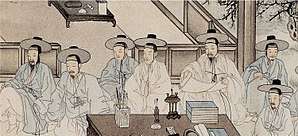 |
| Part of a series on the |
| Culture of Korea |
|---|
| History |
|
Music and performing arts |
|
|
Monuments |
|
National symbols of Korea |
|
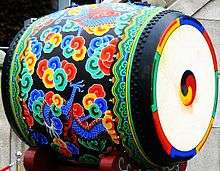
The contemporary culture of South Korea developed from the traditional culture of Korea which was prevalent in the early Korean nomadic tribes. By maintaining thousands of years of ancient Korean with influence from ancient Chinese culture South Korea split on its own path of cultural development away from North Korean culture since the division of Korea in 1948. The industrialization, urbanization and westernization of South Korea, especially Seoul, have brought many changes to the way Korean people live. Changing economics and lifestyles have led to a concentration of population in major cities (and depopulation of the rural countryside), with multi-generational households separating into nuclear family living arrangements. Today, many Korean cultural elements, especially popular culture, have spread across the globe and became one of the most prominent cultural forces in the world. [1][2][3][4][5]
Literature
- See also: Korean literature until 1948, then South Korean literature.
Prior to the 20th century, Korean literature was influenced by Classical Chinese literature. Chinese calligraphy was also extensively used by Koreans for over one thousand years in Korean literature. Modern literature is often linked with the development of hangul, which helped spread literacy from the dominant classes to the common people, including women. Hangul, however, only reached a dominant position in Korean literature in the second half of the 19th century, resulting in a major growth in Korean literature. Sinsoseol, for instance, are novels written in hangul.
In modern poetry, there were attempts at introducing imagist and modern poetry methods particularly in translations of early American moderns such as Ezra Pound and T. S. Eliot in the early 20th century. In the early Republic period, patriotic works were very successful.
Lyric poetry dominated from the 1970s onwards. Poetry is quite popular in contemporary South Korea, both in terms of number of works published and lay writing.
Jeju Island
Jeju Island is a small island located 64 kilometers south of the Korean Peninsula. This semitropical island is approximately 714 sq miles in size and is a popular tourist and honeymoon destination. “Jeju Island features a volcanic Hallasan commanding the island from the center, a 224-kilometer semi-tropical forested national park, a wild coastline dotted with waterfalls and the longest lava tube in the world.” (Barclay, 2017, p.1)[6] Jeju Island is nicknamed “the Hawaii of Korea” and “Island of the Gods” and is a favorite vacation shop for thousands of Koreans.
Formed by cooling lava that has formed deep in the ground and has sprouted to the surface the Manjanggul Cave (만장굴) lava tubes reach a length of over eight kilometers long. These lava tubes are a popular tourist destination due to the fact that its dramatic landscape and multi-shaped rock formations have made it an aesthetic beauty that is deemed one of the finest lava tubes systems caves in the world. Another popular tourist destination on Jeju Island is the Yemiji Botanical Garden (여미지 식물원) which is the largest arboretum in Asia that displays more than 3,700 species of plants and flowers in its 12,210 square meter greenhouse (Hyun-jin, 2001, p.1).[7] Both of these popular tourist destinations add to the beautiful landscape of Jeju Island.
One unique cultural aspect of Jeju is the female divers known as Haenyeo. (해녀) These female divers hold their breath and free dive to the bottom of the sea to gather urchins, shellfish, and abalone. These sea women use no breathing equipment and dive as deep as ten meters underwater using only old-fashioned scuba masks and lead weights tied to their waist. The tradition of female divers began at some point around the 1600s when women started diving for work. The male population on Jeju had drained many men away from the island to fight in foreign wars so the female population stepped up their duties and started diving as a profession. In the 1960s, at their apex, there were 23,000 Haenyeo divers but today there remains only 4,300 due to the pollution that destroyed the fragile aquatic ecosystem around Jeju’s waters (Cataneo, n.d., p.1).[8] Today there is a Jeju Haenyeo Museum located on the north east side of the island that exhibits the unique activities and culture of Jeiudo’s Haenyeo female divers.
Another interesting cultural aspect of Jeju is the people's close relationship between a tradition of shamanism and the strong character of women. Jeju has more than 400 shamanic shrines spread all over the island and the people often hold public shamanic rituals honoring women goddesses. Many popular rituals have a strong emphasis on women’s strength and character such as the worship of Yeongdeung-gut who is the goddess of diving women and fishermen (Herald, 2011, p.2).[9] Another popular shamanism belief centers around Jeju’s creation story, which focuses on a giant goodness named Seolmundae Halmang, in which the sacred Mount Halla central volcano is her embodiment. The island's cultural belief and strong oral tradition have a great proportion of goddesses and powerful female idols that speak to the character strength of the Jeju woman.
Journalism
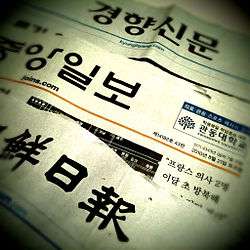
South Korea has 10 main newspapers and 3 main broadcasters. Top three daily newspapers are Chosun Ilbo, Joongang Ilbo, and Donga Ilbo. The Hankyoreh is a left-leaning newspaper. KBS, MBC, and SBS are the main TV channels. Also, there is EBS for student and adult education.
South Korea also has several newspaper and magazines publications. One of the more popular ones is The Chosun Ilbo, which is an online presentation of the Korean daily The Chosun Ilbo. Other magazines are K Scene Magazine, JoongAng Daily, Korea Post, Korea Times, Yonhap News Agency, OhmyNews International. The Korea Herald and PRKorea Times are English language newspapers for foreigners, providing live stories from all over the world.
Although the main newspapers offer online content in Korean and/or English, there are several online-only publications. Several online publications are Digital Chosunilbo, Seoul Times, Korean Government Homepage, and Donga.com which is an online service providing Korean news in several languages. OhmyNews is a Korean website established by Oh Yeon Ho in 2000 in the view that ordinary people could report in by phone or email and have their many views on stories edited by volunteer and professional editors. OhmyNews did the first interview of then-president-elect, Roh Moo-hyun.[10]
Foreign influences

South Korea has historically been influenced by China, and in recent years by the Western world, particularly the United States. The influence of Western culture and rapid modernization has changed peoples' eating habits as well; many people now enjoy Western and other Asian foods in addition to traditional Korean food. Pizza is one of the favorite foreign foods among South Koreans, though it tends to differ from the pizza served in the west, often featuring corn, sweet potato, mayonnaise, bulgogi and various other ingredients. Many Western hamburger, chicken, coffee, and ice cream chains are also very popular in South Korea. Coffeehouses operated by 12 major brands increased to over 2,000 locations in 2010,[11] and the term "coffice" (커피스)[12] was coined to describe using a cafe as an office.[13]
Recently, the Korean language has had a huge influx of English words, sometimes expressed as Konglish. Examples of Konglish include:
- Eye shopping (ai syopping 아이 쇼핑) refers to 'window shopping'.
- Service (seobisseu 서비스) usually means 'complimentary', such as a gift with purchase or warranty service.
- Hand phone (hendeu pon 핸드폰) refers to 'mobile phone'.
- Paiting or Hwaiting (a loanword from 'fighting', English) is a phrase used to 'cheer' someone during a difficult trial.
- One shot is a phrase used while drinking similar to bottoms up, suggesting to down your drink in one go.
Also because the English alphabet has letters that do not exist in the Korean alphabet other letters are usually substituted for others when referring to certain English words. The letter F is replaced with the letter P and the letter Z replaced with the letter J:
- Keopi (coffee)
- Pija (pizza)
Technology
Cellular phones

An estimated 98% of South Koreans own mobile phones and use them not only for calling and messaging but also for watching live TV, viewing websites and keeping track of their online gaming statuses. South Korean corporations Samsung and LG are one of the largest cell phone companies in the world. New phones are expensive in South Korea, but this does not stop South Korean consumers changing their phones on average every 11 months.
Many South Korean phones feature TV broadcasting through Digital Multimedia Broadcasting (DMB), which now carries seven TV channels. Over one million DMB phones have been sold, and providers like KT and SK Telecom have provided coverage throughout many parts of major cities.
Nokia, one of the world's largest cellphone companies, has dropped selling its phones in South Korea because of its decreasing sales. Motorola holds a 4% shares of cellphone sales in South Korea.
South Korea won the LG Mobile World Cup, a texting competition run by LG Electronics.[14]
Games
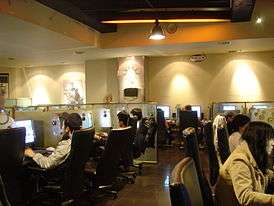
Online game
Korea is known as an e-sports powerhouse. Korea is also famous for producing the best athletes in e-sports. As the perceptions of games have changed, the Korean game market has grown in size and popularized. Korean companies are expected to spur M sports industry, calling mobile E-sports a M-sport.
History
Video games in South Korea have been growing in popularity since the mid-1980s, however it was not until the early 2000s that their popularity skyrocketed. Their sudden growth was due to immensely popular games, such as “Ragnarok Online”, “Maple Story”, and “Lineage II”. Since then, the Gaming industry in South Korea has been steadily growing every year. Its projected market revenue for 2018 is 10.5 billion USD. [15]
Growth in Popularity
The introduction of those games in the early 2000s, as well as the introduction of several new international tournaments, like The World Cyber Games, Electronic Sports World Cup, and Major League Gaming, have allowed the video game industry to grow at a much faster rate. In these tournaments, competitive games would be played for large prizes, some being as much as 1 million USD. The tournaments are very popular in South Korea, and attract a large viewership. Researchers have estimated that the eSports industry will reach 1 billion USD in revenue by 2019. [16]
PC Bangs
In South Korea video games are becoming incredibly popular, but not everyone is capable of affording the equipment necessary to play some of the more complex games on the market. This has led to the growth of the PC Bang, or “PC Room” industry, which is a public café dedicated to enabling anyone to play on high end machines for low cost per hour. There is currently around 25,000 PC Bangs in South Korea alone, with rates at around $0.44 - $1.30 per hour. [17] A key reason why they are so popular in South Korea is due to how inexpensive they are per hour. Making it a good place to meet someone with similar interests and hang out after school, or to take a break from studying. [18]
Addiction
As video gaming is becoming much more popular in South Korea, it also bring up worries of the welfare of the nation’s youth. Video Game Addiction has been a concerning issue with in the South Korean government. Considerable amounts of funds have been invested into programs and campaigns to reduce this issue. One action that the government imposed was the “Cinderella Law”, also known as the Shutdown law. This law prevents anyone aged under 16 from playing online from times 10pm until 6am. [19]
Popular Media
StarCraft, the PC real-time strategy game, was the most popular televised game in Korea. Games are often broadcast on TV stations such as MBCGame and Ongamenet. These tournaments are usually broadcast live and have sizable crowds while they are recorded at shopping malls like COEX, in southeast Seoul. Professional StarCraft players can command considerable salaries in Korea, and are usually noted celebrities, such as Lim "BoxeR" Yo-Hwan. In recent years, professional video gaming in South Korea has branched out away from just Starcraft into a variety of different titles, including Dota 2, League of Legends, Starcraft 2, and Overwatch
Drinking Games
In the drinking culture of South Korea often with a group of individuals, drinking games are played. A variety of games can be played within the group and can change with every coming round. The type of alcohol can vary, but more than likely soju, a common Korean liquor, is used when the games are being played. Sometimes people mix soju and beer and call it "So-Mack," so for soju, and Mack for beer, since beer is called "Maek-joo" in Korean.
Popular culture
Pop music
Many Korean pop stars and groups are spreading throughout East Asia and Southeast Asia. K-pop often features young performers. In the 1970s and 1980s, many musicians appeared, such as Cho Yong Pil, a renowned musician from that period. He used many sources such as the synthesizer. Among his influence, he is well known for popularizing rock music. The popularization of Korean pop music has come from many sources including, YouTube and other video streaming sources. With the growth of social media, it has helped with the expansion of K-pop globally.[20] The dominant explanation of the global K-pop phenomenon is the "hybritity" view that advances a liberal argument about Chinese, Japanese, and Indian cultures as a grand Asian Culture (AC) that may countervail the dominant West Culture (WC) as a whole (Chua, 2004). K-pop became one of Korea's top exporting industries with its rapid and wide spread popularity around the world particularly in the East. Korean popular culture has a timely commercial combination of: (1) the global liberalization of music markets in Asia and the rest of the world; and (2) the rapid advancement of digital technologies like YouTube which prefers to select and feature perfectly photogenic performers from all over the world, including Korean girl and boy bands (Oh, 391).
The emergence of the group Seo Taiji and Boys in 1992 marked a turning point for Korean popular music, by incorporating elements of American popular musical genres of the 1990s. To illustrate, their popularity was based on innovative hybridization of music as they creatively mixed the genres like rap, soul, rock and roll, techno, punk, hardcore and even ppongjjak, and invented a unique musical form which 'employs rap only during the verses, singing choruses in a pop style' with dynamic dance movements. They showed how Korean rap would sound. Consequently, Seo Taiji and Boys expanded the scope of K-pop.[21]
Popular artists who diverge from the K-pop sound include soloists such as BoA, Lee Hyori, IU, Rain, rapper PSY, boy bands H.O.T, Shinhwa, Infinite, TVXQ, Super Junior, BIGBANG, SHINee, iKON, 2PM, U-Kiss, B1A4, EXO, NCT, F.T. Island, 2AM, CNBLUE, MBLAQ, SS501, Beast, GOT7, BTS, B.A.P, Seventeen, Monsta X, VIXX and girl groups Girls' Generation, T-ARA, 2NE1, SISTAR, Kara, Apink, Brown Eyed Girls, 4minute, After School, Wonder Girls, f(x), Miss A, Red Velvet, Davichi, BLACKPINK, TWICE, and many more. South Korea is also home to its own form of hip hop artists, including Drunken Tiger, Leessang, MC Mong, Epik High, Dynamic Duo, Block B, Jay Park and BIGBANG leader and member GDragon.
In 2002 BoA became the first Korean pop star to break through in Japan following the fall of barriers that had restricted the import and export of entertainment between the countries since the end of World War II. For that reason,she was awarded the title of Goodwill Ambassador, and has since contributed to restoring the good relations between Japan and South Korea. .
Some songs from popular bands and groups formed dance crazes, such as "Mirotic" by TVXQ, "Sorry Sorry" and "Bonamana" by Super Junior, "Tell Me" and "Nobody" by the Wonder Girls, "On Rainy Days" and "Fiction" by Beast ,"Fire" and "I Am the Best" by 2NE1, "Fantastic Baby" by BIGBANG, "(Alone)" by CNBLUE, "Sherlock" by SHINee, "Roly Poly" by T-ara "Gee" by Girls' Generation, "Nu ABO" by f(x), "BTD by Infinite, "Beautiful Target" by B1A4, "Gangnam Style" by PSY, "Growl","Wolf", "Overdose" by EXO, "Blood Sweat & Tears" by BTS and "TT" by TWICE. These dance crazes would often spread quickly throughout Asia, inspiring many people to imitate them in talk shows, commercials, and even political campaigns. Because of their addictive sound and inspired dance crazes, some of these songs have subsequently won musical awards, such as the "Song of the Year".
In addition, there is also traditional Korean pop music, or trot. Appealing to older Koreans, there are many popular singers, including Tae Jin Ah, Na Hoon-a and Song Dae Kwan, mainly in their 50s and 60s, if not older. However, trot has recently experienced a resurgence due to the popularity of Jang Yoon Jeong, a young semi-trot star, who had a breakout hit with "Omona."
Noraebang
Karaoke is most commonly called "Noraebang" (노래방, literally, "song room") in Korea, but various Korean alternatives like Norae yeonseupjang (노래연습장), or Norae yeonseupshil (노래연습실) are also sometimes used. Noraebang is even conducted in transport vehicles such as tourist buses. Noraebang is the equivalent to the Karaoke-Box in Japan, whereas singing before an audience of a karaoke bar is called Karaoke (가라오케) in Korea. Recently, a coin karaoke, which is a form of payment different from the existing karaoke, appeared.
Korean Popular Culture on a Global Level
There are approximately 70,000 Korean students in American colleges every year. Furthermore, increased immigration has reached to booming heights of over a million in 2010 alone. With these migrations have come the spread and expansion of Korean Popular culture. Known as the "Korean Wave", Hallyu in the United States and alike has led to Korean movies, art, fashion, and music reaching popularity like never before. For example, the popular South Korean film titled "Shiri (쉬리)" sold more than 5.78 million movie tickets in the United States alone.[22]
One of the reasons for the success of the Korean Wave comes from the influence the Korean government has in the production and distribution of popular culture. Recent years have led to changes in access to both enjoying and creating new songs, movies, and other types of popular culture. Furthermore, reconfiguring Korean elements into more Westernized ideas has helped increase popularity. One example comes from recent collaboration with the Korean Government and others to help achieve glocalization, making hallyu approachable and enjoyable for people from many different cultures and backgrounds.[23]
Film and Television
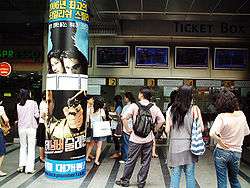
Since the success of the Korean film Shiri in 1999, Korean film has become much more popular, both in South Korea and abroad. Today South Korea is one of the few countries where Hollywood productions do not enjoy a dominant share of the domestic market. This fact, however, is partly due to the existence of screen quotas requiring cinemas to show Korean films at least 73 days a year.
Shiri was a film about a North Korean spy preparing a coup in Seoul. The film was the first in Korean history to sell more than two million tickets in Seoul alone. Shiri alone earned $14 million at the Japanese box office. This helped Shiri to surpass box office hits such as The Matrix and Star Wars. The success of Shiri motivated other Korean films with larger budgets. With the release of the Korean film Shiri, it attracted 5.8 million theatre-goers. These numbers out scored the local theater attendance for the American made film from Hollywood, Titanic. The venture capital firm, KDB Capital was the main firm that invested money into the production of Shiri. KDB Capital invested around $333,000 in the movie and would end up earning more than 300 percent in returns (Shim, 33). This is what helped spark the Korean governments interest in the possible profits that can be awarded through the entertainment industry.
In 2000 the film Joint Security Area was a huge success and even surpassed the benchmark set by Shiri. One year later, the film Friend managed the same. In South Korea the romantic comedy My Sassy Girl outsold The Lord of the Rings and Harry Potter which ran at the same time. Park Chan-wook, the director of Joint Security Area, has gone on to direct many popular films in Korea and abroad, and is especially known for the cult film of 2003, Oldboy. Kim Ki-Duk is also a well-respected filmmaker and is known for using minimal dialogue between characters to create an emotional response from the audience. He is known especially for 3-Iron and Spring, Summer, Fall, Winter... and Spring. As of 2004, new films continue to break records, and many Korean productions are more popular than Hollywood films. Both Silmido and Taegukgi (The Brotherhood) were watched by over 10 million people, which is almost a quarter of the Korean population. Silmido is a film based on a true story about a secret special force. The other is a blockbuster movie about the Korean War directed by the director of Shiri. The Host (2006) part monster movie, part social satire broke Korean box office records and has become fairly popular in the United States as well.
This success attracted the attention of Hollywood. Films such as Shiri are now distributed in the United States. In 2001, Miramax bought the rights to an Americanized remake of the successful Korean action comedy movie, My Wife is a Gangster.
Many Korean films also reflect the unique circumstances of the division and reunification of Korea.
Dramas
Korean television and especially the short form dramatic mini-series colloquially called "dramas" by Koreans have become extremely popular outside of Korea. Dramas were foremost among cultural exports driving the Korean Wave trend in Asia and elsewhere. The trend has driven Korean stars to fame and has done much to boost the image and prestige of Korean popular culture. One example that the Korean Wave of drama have come into existence is in 1997, when the national China Central Television Station (CCTV) aired a Korean television drama, What is Love All About?, turned out to be a big hit. In response to popular demand, CCTV re-aired the program in 1998 and recorded the second-highest ratings ever in the history of Chinese television. In 1999, in Taiwan and China, another Korean television drama serial Stars in My Heart, became a big hit. Since then, Korean television dramas have rapidly taken up airtime on television channels in countries such as Hong Kong, Taiwan, Singapore, Vietnam and Indonesia, which saw media liberalization beginning in the 1990s.[24]
Dramas showcase a wide range of stories, but the most prominent among the export dramas have been romance (All About Eve, Autumn Fairy Tale, Winter Sonata, My Fair Lady, Stairway to Heaven, Full House, My Name is Kim Sam Soon, Goong, My Girl, Boys Over Flowers, Shining Inheritance, You're Beautiful, Heartstrings, Secret Garden, Dream High) and historical fantasy dramas (Dae Jang Geum, Emperor of the Sea, Jumong, Sungkyunkwan Scandal). Korea has also aired their first blockbuster spy drama, IRIS.
Korean animation
While The Simpsons is the best known back-room product of South Korea, many other popular English-language animation series (Futurama, King of the Hill, Avatar: The Last Airbender, Family Guy) have had the basic animation, in-betweening, and coloring done in South Korea; there has also been some South Korean collaborations and minor contributions on anime from Japan. This work is professional, but not necessarily Korean in tone or manner.
Recently, the animation Pororo the Little Penguin became one of the most popular cultural exports of South Korea, by exporting Pororo to 120 countries worldwide.[25] This little blue penguin has 1,500 spin-off products and a section in a theme park. Pororo is so powerful that Koreans call him Potongryong ("President Pororo"). According to the Seoul Business Agency, Pororo will generate global sales of 38 billion won (approximately US$36 million) this year, and the brand is worth 389.3 billion won for Iconix (the firm that created it) and others.[26]
See also
References
- ↑ Yong Jin, Dal (2011). "Hallyu 2.0: The New Korean Wave in the Creative Industry". International Institute Journal. 2 (1).
- ↑ CNN, By Lara Farrar for. "'Korean Wave' of pop culture sweeps across Asia".
- ↑ "The Global Impact of South Korean Popular Culture: Hallyu Unbound ed. by Valentina Marinescu". ResearchGate.
- ↑ Kim, Harry (2 February 2016). "Surfing the Korean Wave: How K-pop is taking over the world | The McGill Tribune". The McGill Tribune.
- ↑ Duong Nguyen Hoai Phuong, Duong Nguyen Hoai Phuong. "Korean Wave as Cultural Imperialism" (PDF).
- ↑ Barclay, J. (2017, July 12). 10 reasons travelers can't keep away from Jeju Island. Retrieved from http://www.cnn.com/travel/article/things-do-jeju-island/index.html
- ↑ Hyun-jin, S. (2001, November 30). Jeju-do: Exotic island of natural wonders; City of Seogwipo on Jeju Island set to stun visitors during World Cup. Korea Herald. Retrieved from http://www-lexisnexis-com.ezproxy.umuc.edu/hottopics/lnacademic/?verb=sr&csi=237924,270944,270077,11059,8411&stp=fr&sr=jejuisland%5Bpermanent+dead+link%5D
- ↑ Cataneo, E. (n.d.). The female free divers of jeju. Retrieved from http://roadsandkingdoms.com/2017/the-female-free-divers-of-jeju/
- ↑ Korea Herald. (2011, November 13). Beyond tangerines and beaches: Jeju’s unique culture. Retrieved from http://www.koreaherald.com/view.php?ud=20111113000069
- ↑ "South Korean Newspapers and News Sites". World-newspapers.com. Retrieved 2015-05-20.
- ↑ "In Korea, coffee shops just keep on multiplying". Korea Joongang Daily/IHT. August 30, 2010.
- ↑ COACHING DECO Archived 2011-07-07 at the Wayback Machine. Elle Magazine Korea 2009.10.01
- ↑ Schott, Ben (September 10, 2010). "Coffice". The New York Times.
- ↑ Choe, Sang-Hun (27 January 2010). "Rule of Thumbs: Koreans Reign in Texting World". The New York Times. Seoul. Retrieved 8 February 2010.
- ↑ +ableau. (2017). Game market revenue in South Korea from 2013 to 2018 (in trillion Korean won). Retrieved from Statista: https://www.statista.com/statistics/248666/game-sales-in-south-korea/
- ↑ Harmon, A. (2015, January 1). Electronic sports.. Salem Press Encyclopedia., p. 2p.
- ↑ Ihlwan, M. (2007, 3 27). South Korea: Video Games' Crazed Capital. BusinessWeek Online. , pp. p21-21. 1p.
- ↑ 1p. Schaeffer, J. (2007, November 1). Hanging Out at the PC Bang. . Faces., Vol. 24 Issue 3, pp. p20-22. 3p.
- ↑ Zhou, P. (2017, 3 14). South Korea Computer Gaming Culture . Retrieved from ThoughtCo.: https://www.thoughtco.com/south-korea-computer-gaming-culture-1434484
- ↑ Lie, John (2014). K-Pop. California: University of California Press. p. 108.
- ↑ Lenchner, Frank J; et al. (2012). The Globalization Reader. Willey-Blackwell. p. 362. ISBN 978-0-470-65563-4.
- ↑ Ter Molen, Sherri L. “A Cultural Imperialistic Homecoming: The Korean Wave Reaches the United States.” .” In Yasue Kuwahara ed., Korean Wave: Korean Popular Culture in Global Context (Basingstoke, GBR: Palgrave Mcmillan, 2014), 149-179.
- ↑ Ju, Hyejung. “Transformations of the Korean Media Industry by the Korean Wave: The Perspective of Glocalization.” In Yasue Kuwahara ed., Korean Wave: Korean Popular Culture in Global Context (Basingstoke, GBR: Palgrave Mcmillan, 2014),
- ↑ Lenchner, Frank J; et al. (2012). The Globalization Reader. Wiley Blackwell. p. 359. ISBN 978-0-470-65563-4.
- ↑ Kim, Hana. "The Secret of Pororo reaching 389 Billion Success (3890억원 갑부 뽀로로, 성공 비결 알려준다)". Hankyoung Economics (한국경제). Retrieved 1 June 2012.
- ↑ "Korean animation : Of penguins and politics Pororo the penguin could be the next Teletubbies". The Economist. Jul 7, 2011. Retrieved 1 June 2012.